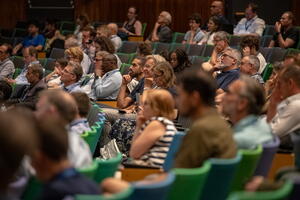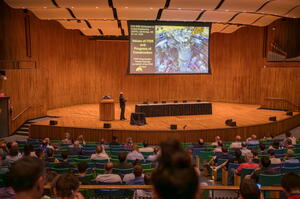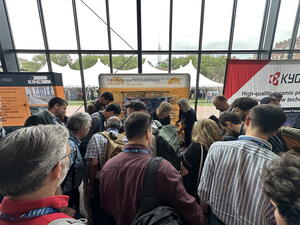“Fusion is the solution that scales”
The 31st IEEE Symposium on Fusion Engineering (SOFE) in Boston from 23 to 26 June was the occasion to measure just how fast the fusion ecosystem is changing.
Technical Chair Sehila M. Gonzalez de Vicente of the Clean Air Task Force described this year's SOFE as by far the largest to date, noting that the biennial conference has doubled in size over the past decade. Not even the unprecedented heat dome—bringing extreme temperatures and humidity to the host city—could dampen the enthusiasm of the 700 attendees. Participants engaged with enthusiasm in presentations, poster sessions, networking events, and side activities, including a visit to the Devens, Massachusetts campus of the private firm Commonwealth Fusion Systems (CFS).
SOFE 2025 General Chair Greg Wallace, from MIT’s Plasma Science and Fusion Center (PSFC), opened the conference by describing the field of fusion as being on the brink of major breakthroughs. “It’s incredible to see how many companies are jumping feet first into fusion,” he said. “But it is also a time of caution—we haven’t yet solved all the challenges we face.”
Andrew Holland, CEO of the Fusion Industry Association, echoed the sense of momentum, describing a “sea change” underway. To date, at least USD 8 billion in private investment has been directed toward 45 fusion companies across 14 countries, most of it in the last five years. (The Association’s full 2025 report on the state of the industry is expected in late July.) Holland attributes the rapid growth to increasing supply-side readiness—fusion is edging closer to commercial viability—and to the emergence of a “venture-capital mindset” that is reshaping the business model. “No longer do we have to solve all the problems before moving forward,” he said. He likens the proliferation of startups to “shots on goal.” “These are companies that are moving fast. No one can know in advance who is going to get there first.” Commonwealth Fusion Systems co-founder and director Bob Mumgaard predicts that recent advances in fusion technology, especially high-temperature superconducting magnets, mean that “fusion is the solution that scales.”
Jean Paul Allain, Associate Director of the US Office of Fusion Energy Sciences, agrees that the private sector is moving fast, but says that there is still a need to derisk some technology gaps. “Free markets will dictate who wins and loses,” he said in a talk on public/private partnerships. “But as we think about what it will take to realize fusion energy, it is important to recognize that foundational science is the engine of innovation. Decades of investment from the public sector has created an ecosystem of national labs and universities that are nurturing other efforts today. Through this publicly enabled knowledge base we are looking at many different approaches to fusion and looking for multiple demonstrators.”
The ITER project was represented at SOFE 2025 through a number of presentations and poster sessions. Deputy Director-General for Science & Technology Yutaka Kamada gave a plenary talk that emphasized how ITER is driving the availability of key fusion technologies. “Anywhere between 100 and 500 companies in each of the ITER Members have been involved in the successful fabrication of high-precision components for ITER,” he said. “That translates to thousands of companies working for fusion. ITER has created a fusion supply chain over the last decade by bringing fusion from science to industry.”
And ITER is contributing value to the ecosystem in other ways too, he said. By operating deuterium-tritium plasmas at a scale not experienceable in other devices, the project will provide important knowledge on disruption control, on the diagnostics critical to operating a fusion plasma, on maintainability, on fuel cycle and on fusion codes and standards ... among other valuable lessons from operation. “ITER will deliver the scientific basis for practical fusion energy,” agreed Kathy McCarthy, director of the US ITER Project Office, in her session on the value of ITER.
Reflecting one of the top priorities of the new fusion startups, the conference opened with a talk by MIT Professor of Finance Andrew Lo. He proposed acting as a “fresh pair of eyes” and telling the audience how fusion looks to an outsider—especially an outside investor. He considers fusion energy as part of a group of transformational technologies (think quantum computing, drug development, climate tech…) that involve complex engineering or scientific challenges, that are deeply risky, but that potentially offer huge returns on investment. He describes investors are willing to take risks, but deeply suspicious of uncertainty. His advice to private firms? “If you can measure what you are doing and show how uncertainty will be resolved progressively, you’ll be better at raising money.”
In approximately 100 technical talks, experts in practically every fusion engineering domain—magnets, cryogenic systems, fuelling, exhaust, vacuum, diagnostics, control, power supply, blankets, materials, tritium breeding, heating and current drive, remote handling, safety and regulation—shared the latest progress and the challenges they are facing. Many of the talks will be published in an upcoming special issue of IEEE Transactions on Plasma Science (TPS), a peer-reviewed journal.
The conference closed with the recognition of the IEEE Fusion Technology Award winners Fernanda Rimini (2024), for her leadership in JET’s deuterium-tritium operations, and Zach Hartwig (2025), MIT professor (Department of Nuclear Science and Engineering) and co-founder of Commonwealth Fusion Systems. The awards celebrate outstanding contributions to research and development in the field of fusion technology.
Photos courtesy of Tamás Szabolics, EUROfusion




